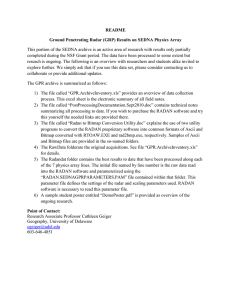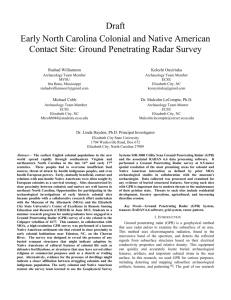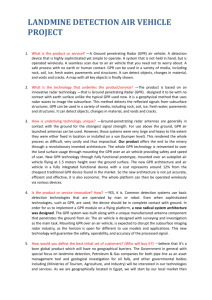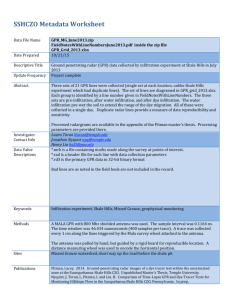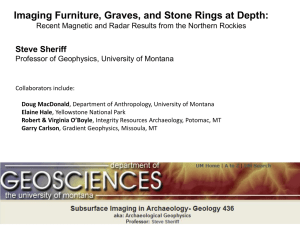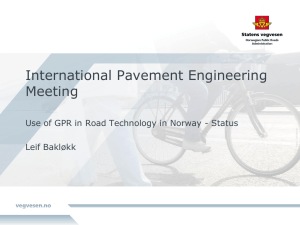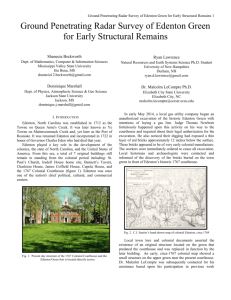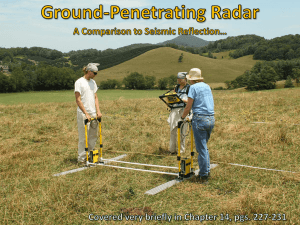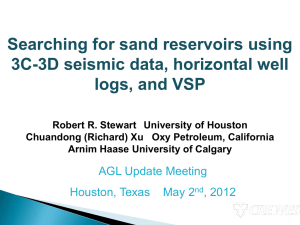Ground Penetrating Radar (GPR) - NIA
advertisement
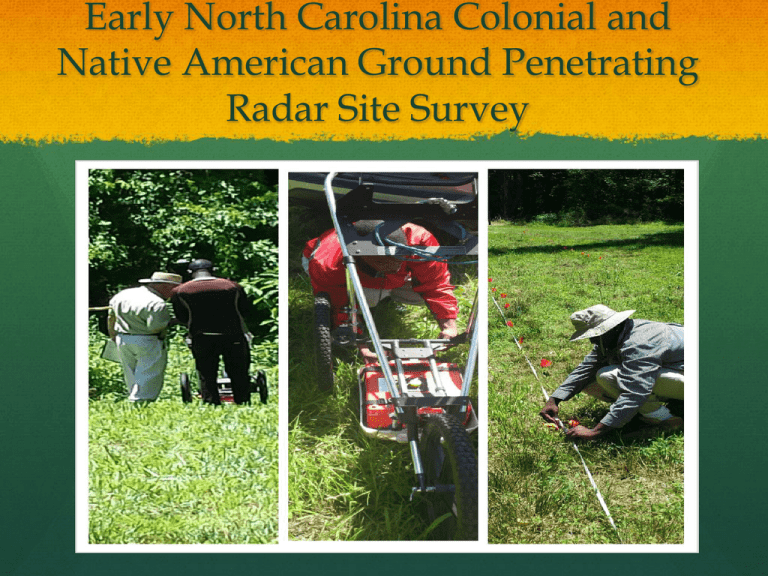
Early North Carolina Colonial and Native American Ground Penetrating Radar Site Survey Archaeology Team Members Michael Cobb Elizabeth City State University Rashad Williamson Mississippi Valley State University Team Mentor Dr. Malcolm LeCompte Elizabeth City State University Kelechi Onyiriuka Elizabeth City State University Abstract The earliest English colonial populations in the new world spread rapidly through southeastern Virginia and northeastern North Carolina in the late 16th and early 17th centuries. These peoples had to overcome insufficient food sources, threat of attack by hostile indigenous peoples and even hostile European powers. Early, mutually beneficial, contact and relations with non-hostile Native Americans were often sought by European colonists as a survival strategy. Sites characterized by close proximity between colonists and natives are well known in northeastern North Carolina. Opportunities for expanded archaeological investigations of early historic colonial sites became possible with a collaborative research effort undertaken with the Museum of the Albemarle (MOA) and the Elizabeth City State University’s Center of Excellence in Remote Sensing Education and Research (CERSER) in June, 2012. Students in a summer research program for undergraduates engaged in a Ground Penetrating Radar (GPR) survey of a site related to the Culpeper rebellion of 1677. Abstract Continued This summer, in collaboration with MOA, a high-resolution GPR survey will be performed of a known Native American settlement site that existed in close proximity to early colonial habitations near Edenton, NC, on the Chowan River. The survey will be designed to reveal the presence of any buried remnant structures that might indicate adoption by Native Americans of cultural features of colonial life such as defensive fortifications, or structures that may have served either religious or commercial purposes such as a church or trading post. Alternatively, evidence for the presence of dwellings might indicate a closer affiliation between struggling colonists and the indigenous population. The Native American colonial contact site survey team will learn to use the Geophysical Survey Systems SIR-3000 Utility Scan Ground Penetrating Radar (GPR) and the associated RADAN 6.6 data processing software. It will perform a Ground Penetrating Radar survey at 0.5-meter spatial resolution of the most promising areas for colonist and Native American interaction as defined by prior MOA archaeological studies in collaboration with the museum’s archaeologist. Data collected will be processed and examined for any evidence of buried structural features. Surveying such sites with GPR is important due to modern threats to the maintenance of their pristine state. Threats to such sites include agricultural and forestry operations, commercial and residential development, and increasing shoreline erosion. Background History Why did Europeans want to venture to North America? Gold Sassafras Medicinal purposes Why did MOA choose the site? Fresh Spring Water Fish and Wild Game (food source) Wood for Construction Natural Defense Tributary Creek Shelter Cove Shallow Water Purpose Ground Penetrating Radar (GPR), to examine a predetermined location for evidence of any buried structures evident of possible Native American, or colonial habitation. What is GPR? The radar transmits high frequency, short duration pulses of energy. Transient electromagnetic waves are reflected, refracted, and diffracted in the subsurface by changes in electrical conductivity. Travel of waves are analyzed to give depths, geometry and material type information. The energy returning to the antenna is processed within the control unit and displayed on graphic paper. Equipment & Materials Grid Paper GPR GPS Meter Stick Flags Rope RADAN software Computer (non- Mac) Ground Penetrating Radar (GPR) Methods Site Location The site location was predetermined, and located in Eastern, North Carolina along Chowan River. Methods Grid Preparation The site was mapped out using GPS coordinates, flags, and rope, creating 1 meter grid lines used to better ensure accuracy and precision when surveying the area. The rope was used to guide the GPR. Areas 1 & 2 26.8 M AREA 2 20M Length of Transect 1 M width AREA 1 15M Length of Transect 1 M width 25 M Methods Site surveying and data processing. Completely survey areas 1 and 2. Use the RADAN software to process the data by formulating images at the various depths and a 3D model. Visual Survey Several artifacts were found just by observing the surface of the ground. Pottery Ceramic Plate Parts of possible tools Some objects found were estimated by a local archaeologist to be between 600-2,000 years old. Results Area1 & Area 2 X Transect Length (m) 30 25 Transect Length in Meters Standard Deviations 20 15 10 5 0 0 10 20 30 40 50 Transect Number 60 70 80 90 Area 1 Area 2 24.39 ± 1.11 25.84 ± 0.58 Results Area 1 .25 M .50 M .75 M 1M 1.15 M Results Area 1 1.15 M Results Area 2 .25 M .5 M .75 M 1M 1.25 M 1.5 M Results Area 2 Continued 1.75 M 2.5 M 2M 2.75 M 2.25 M 3M Results Area 2 3D Compilation Conclusions After the completion of this research, we have compiled solid data that has led the archaeology team to determine that there is in fact unknown features in both surveyed areas. The subsurface material shows very intriguing almost even spacing at a depth of 1.15 meters in area one. Area two has a greater amount of subsurface features than area one. Interests in this area are high due to the abundance of material. Future Research Further investigation at the site is needed to determine the identity of the unknown. We suggest that a larger area be surveyed at a higher resolution. Archeologists will have to determine if there is sufficient data that will warrant excavation. Acknowledgments We would like to thank Dr. Malcolm LeCompte for being an amazing mentor to the team; he encouraged us in numerous capacities. We also would like to extend a thank you to Edward Clay Swindle and MOA for the assistance with helping us obtain access to the research site. We warm-heartedly would like to thank Dr. Linda Hayden and CReSIS for giving us the opportunity to participate in such a program that allowed our minds to engage in learning, exploring, and developing a new understanding of science. Daniels DJ (ed.) (2004). Ground Penetrating Radar (2nd ed.). Knoval (Institution of Engineering and Technology). Conyers, Lawrence B. And Dean Goodman 1997 Ground Penetrating Radar: An Introduction for Archaeologists. Walnut Creek, CA.: Altamira Press Radan 6.6 User’s Manual, “The Difference is in the Data” 2005. Published by Geophysical Survey System, Inc. http://therearenosunglasses.files.wordpress.com/2009/09/fireshot-pro-capture-005-51238777_jpg-jpeg-image-4016x3997pixels-scaled-19-content_answers_com_main_content_img_getty_7_7_51238777_jpg.png http://ed101.bu.edu/StudentDoc/Archives/ED101sp09/kcarle/NativeAmericans.jp g http://cast.uark.edu/nadag/EducationalMaterials/gpr_corner/gpr_corner.htm http://alldirtinc.com/images/excavation.jpg http://depositphotos.com/4993393/stock-illustration-Vintage-compass-rose.html Bibliography
